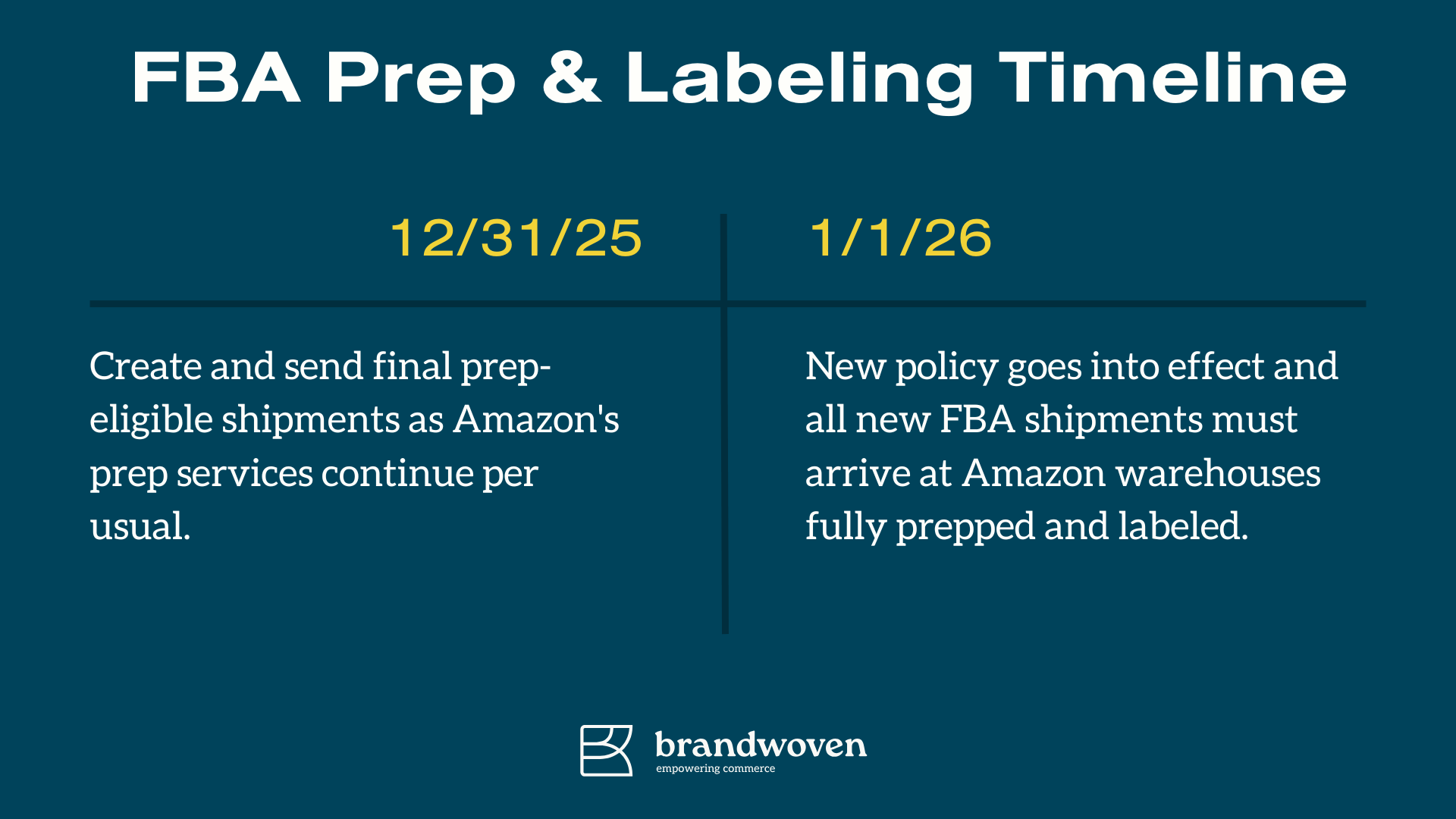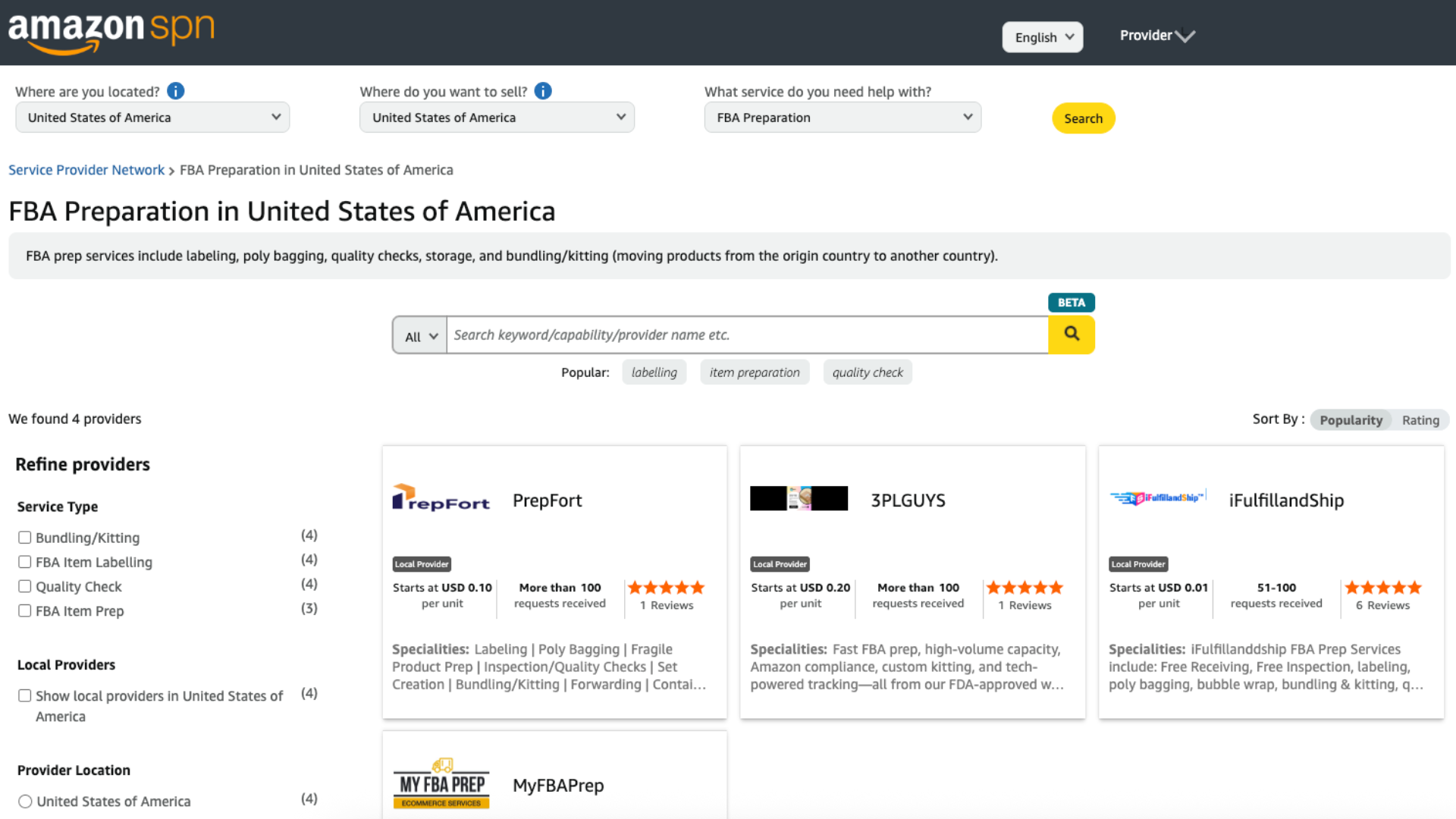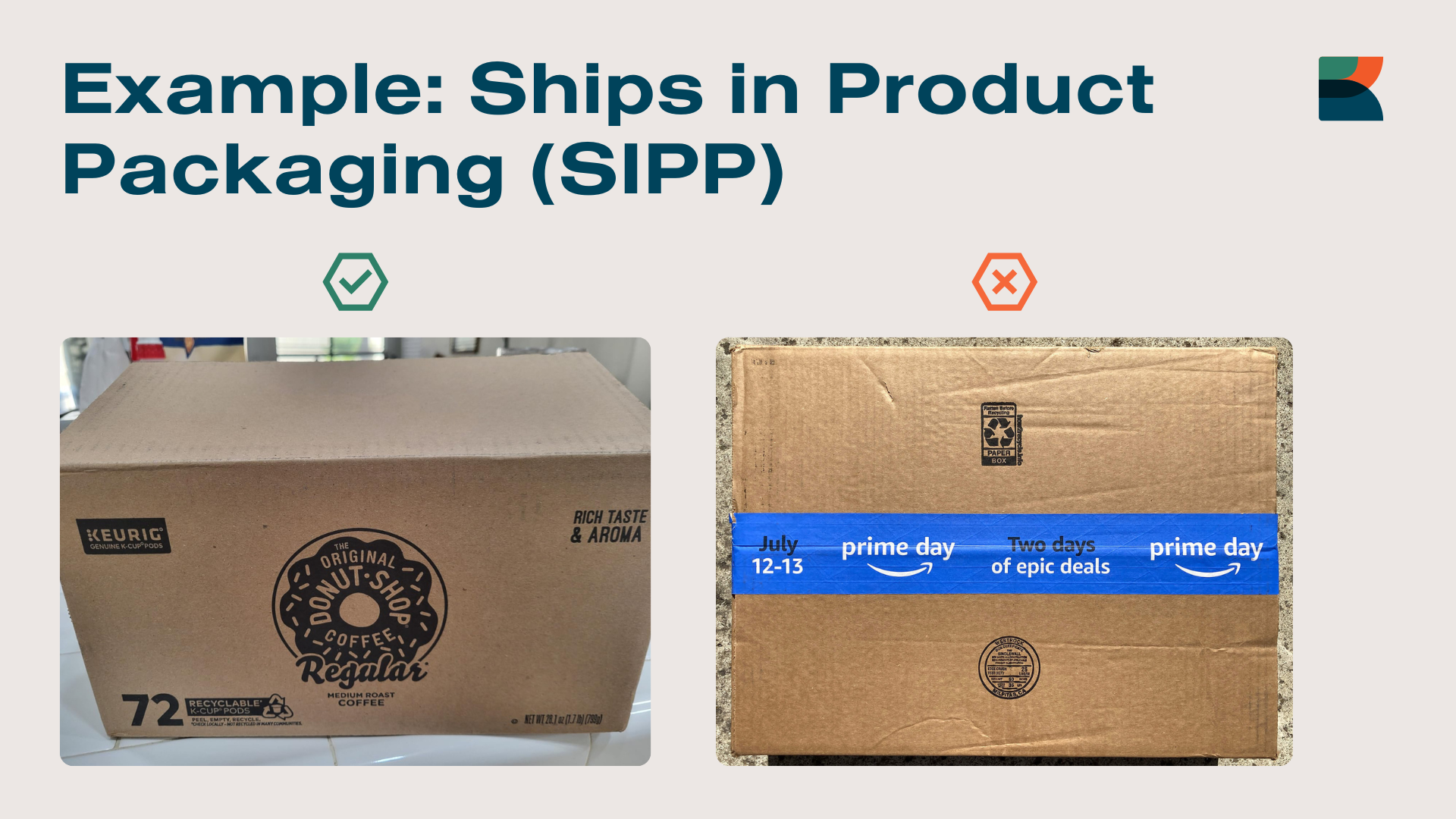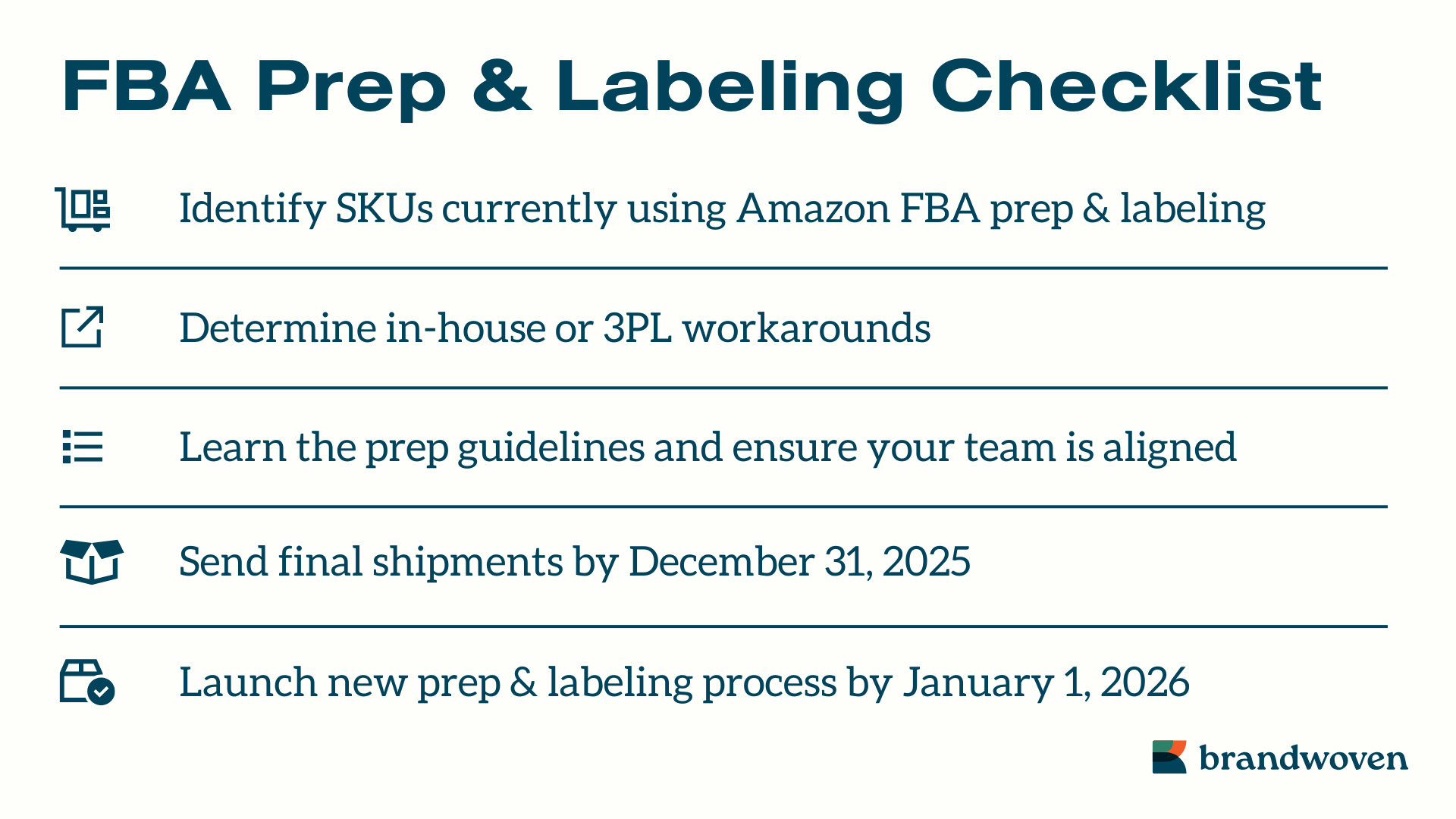Article
Amazon Policy Change: FBA Prep & Labeling Services Leaving in 2026
A Major Shift for Amazon FBA Sellers
Amazon is discontinuing its prep and item labeling services for Fulfilled By Amazon (FBA) shipments in its U.S. marketplace, effective January 1, 2026. This change applies to all inventory sent to Amazon U.S. FBA, including inventory from Amazon Warehousing & Distribution (AWD), Amazon Global Logistics (AGL), Amazon SEND, and Supply Chain Portal.
Previously, Amazon removed prep services specifically for sharp objects (like scissors), but this new policy update extends to all FBA prep & labeling services. This is a significant operational shift that will impact thousands of Amazon sellers who have relied on Amazon to handle their FBA product prep and labeling. It’s crucial for brands to begin working towards an alternative method now to ensure a smooth transition come January 1, 2026.
Understanding the Change and Preparing for 2026
Why is Amazon Making This Change?
Amazon initially introduced FBA prep services to help protect products during shipping. Most sellers manage their own packaging, either independently, through manufacturing partners, or via third-party providers.
This change will allow Amazon FBA to focus on providing faster and more efficient fulfillment center operations and ensure quicker delivery times for customers, rather than spending that time on product prep & labeling. One way to think about it: FBA is the only party who manages fulfillment center operations and delivery whereas there are multiple other parties (including sellers themselves) who can take over management of product prep and labeling.
Overview of FBA Prep & Labeling Services Amazon is Discontinuing
- No longer applying FNSKU barcode labels. This shouldn’t be a big inconvenience to sellers as Amazon also recently announced the end of comingled inventory by early 2026, leading to FNSKU labels no longer being needed.
- No longer poly-bagging or bubble wrapping items on behalf of sellers.
- No longer attaching safety labels (e.g., suffocation warnings) to products.
- No longer bundling multiple units into one sellable set. This now must be done by the seller before the bundle is sent to Amazon’s warehouse.
- Other general prep and item labeling for Amazon FBA sellers.
Amazon Policy Change Timeline
Now until December 31, 2025, Amazon’s FBA prep and labeling services will continue as usual. From January 1, 2026 onwards, all new FBA shipments must arrive at Amazon warehouses fully prepped and labeled.
Note there is a grace period: FBA shipments created before January 1, 2026 that arrive at Amazon warehouses after January 1, 2026 will still receive prep & labeling services (because they were created before the deadline).
Consequences of Non-Compliance with the Amazon Policy Change in 2026
All FBA products must be prepped and labeled before sending them to Amazon facilities. FBA shipments that are created and arrive after January 1, 2026 without proper prep and labeling will not be eligible for reimbursement if items are damaged or lost.
Sellers who do not properly prep and label their FBA inventory in 2026 will risk facing rejected or returned shipments, delays in inventory check-in, or stranded inventory.
The full responsibility for prep now falls on each seller or their third-party partners.
4 Alternative FBA Inventory Prep & Labeling Solutions
1) Convert to Manufacturer Barcodes
Since Amazon is discontinuing the application of FNSKU barcode labels as part of its FBA prep & labeling policy update, this puts the FNSKU barcode labeling responsibility into the hands of the seller. Amazon also recently announced that its process of comingling FBA inventory will be phased out by early 2026, which was the main reason many sellers bothered with FNSKU labels in the first place. Therefore, converting to manufacturer barcodes is the first step we recommend sellers take. As part of the comingling update, manufacturer barcodes will offer virtual tracking (orders will ship from a seller’s own inventory and returns will also be traced back to that same stock), making this barcode switch the first solution you can implement before the 2026 FBA prep & labeling update goes into effect.
2) Outsource to an Amazon Third-Party Logistics (3PL) or FBA Prep Service Provider
Many sellers already use professional third-party Amazon FBA prep service providers, which:
- Receive and confirm inventory
- Handle all Amazon FBA product prep and labeling requirements (bagging, bundling, packing)
- Send FBA inventory shipments directly to Amazon fulfillment centers
Partnering with a 3PL service provider allows your brand to avoid the hassle of keeping up with these evolving Amazon FBA product prep and labeling requirements (risking non-compliance) and instead prioritize scaling your business with high-level strategizing and day-to-day operations instead of repetitive and manual inventory prep tasks.
To find a vetted 3PL service provider that offers product prep, labeling, poly-bagging, quality checks, kitting, bundling, and more, Amazon provides a dedicated FBA Prep Providers category within its Service Provider Network (SPN).
3) Enroll in Amazon Ships in Product Packaging (SIPP) Program, if Eligible
For eligible Amazon products, the Ships in Product Packaging (SIPP) program allows original products to be shipped as is (i.e. ship the item with its own packaging rather than inside a box). Although not all products qualify for this program (based on how durable their existing packaging is), enrolling in the SIPP program will reduce some of your product prep needs, in addition to offering lower Amazon FBA fulfillment fees.
Barcodes will still need to be affixed (which your 3PL service provider can take care of), but this is especially a program we’d recommend to sellers who are handling their FBA product prep & labeling in-house.
4) Handle FBA Prep & Labeling In-House
Sellers can choose to inspect, package, and label each unit themselves in accordance with Amazon’s requirements. Although this is more work for the brand, some may prefer to do so if it aligns with their internal operations capabilities.
Here’s what you need to consider:
- Stock all relevant supplies: poly bags, suffocation warnings, bubble wrap, barcode printers, etc.
- Have trained staff on FBA prep & labeling rules.
- With prep and labeling fully in your control, turnaround time will be solely based on how fast your team can get inventory ready.
- You’ll need space and equipment to handle the prep & labeling tasks.
This responsibility can be especially complex for small teams with bulky items or high product volume. Remember that any mistakes in your prep and labeling efforts can lead to costly delays or other issues with Amazon.
How to Get Ready for the 2026 Amazon FBA Prep & Labeling Policy Change
- Review your SKUs: Identify which products currently rely on Amazon for labeling, bagging, or bundling; these are the ones that will be affected by the policy change.
- Familiarize yourself with FBA prep requirements: Read through Amazon’s guidelines on packaging, labeling, and product protection (e.g., poly bags, bubble wrap, barcodes) so that you know what the prep process entails.
- Audit your current workflow: Determine what Amazon was handling for you and what you’re equipped to manage in-house, if anything.
- Explore the Ships in Product Packaging (SIPP) program: If eligible, enrolling in Amazon SIPP will reduce some of your product prep needs.
- Decide on a prep method: Evaluate the costs and benefits of in-house vs 3PL Amazon FBA prep. Research trusted 3PL service providers now as demand will likely spike closer to the deadline.
- Train your team or suppliers: Ensure everyone involved understands and can consistently follow Amazon’s FBA prep rules.
- Run test shipments: Trial your new prep process before the deadline. Make sure to account for additional transit time if needed/using a 3PL service provider for your Amazon FBA inventory.
- Plan for 2026: Create and send final prep-eligible FBA shipments before December 31, 2025, and get your new system in place for January 1, 2026.
Your Partners Through the Amazon FBA Policy Change
Many sellers find that using a specialized FBA prep partner can speed up check-in at Amazon warehouses, reduce issues, and improve inventory visibility and control.
Brandwoven has expertise in helping brands who have been utilizing Amazon’s FBA prep & labeling services. We can assist you in:
- Auditing your catalog for impacted SKUs
- Finding good-fit alternative solutions
- Optimizing your FBA packaging workflows to avoid disruptions
Reach out to us if you are struggling with Amazon’s newest update and we can offer your team customized recommendations that fit the specific needs of your brand.



